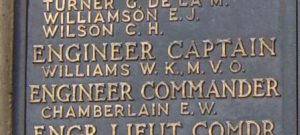London Welsh Rugby Football Club was formed in 1885 by members of London’s Welsh community, based in Old Deer Park, Richmond-upon-Thames. The Welsh name for the club translates as Clwb Rygbi Cymry Llundain. Some twenty-three former London Welsh rugby players lost their lives during the Great War of 1914-1918, several of whom were former Welsh Internationals, and these men have recently been commemorated on a new war memorial which was unveiled at Old Deer Park on 6 November 2021. Several of these men are already commemorated on different war memorials throughout this website as they were from west Wales.
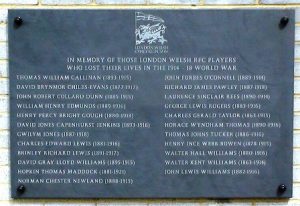
The Great War, 1914-1918
Thomas William Callinan, Second Lieutenant, Durham Light Infantry. Thomas was born in 1883, the son of Reverend Thomas Callinan and Josephine Mellanby Callinan (nee Hodgson), of Broom Vicarage, Durham. He was educated at Bow Preparatory School and at Durham School, where he was captain of the Rugby XV and head boy of the school. Thomas then gained a place at Queen’s College, Cambridge, again playing for the Rugby XV, which he captained, as well as rowing for the College, before graduating BA in 1905. Thomas then held positions as assistant master at Knightsbridge Grammar School and as Modern Language master at Bramcote School, Scarborough before being appointed Modern Language master at Merchant’s Taylor’s School, where he became a member of their Officer Training Corps. Thomas became well known in rugby circles whilst in London, playing at Full Back for London Irish as well as in a combined London Irish and Welsh team against Cambridge University in February 1914. On 12 February 1914 Thomas was commissioned as Second Lieutenant into the Merchant Taylors’ School Contingent, Junior Division, Officers Training Corps, then following the outbreak of war gained a commission into the Durham Light Infantry and was posted to the 8th Battalion, Durham Light Infantry, which was at Gilesgate, Durham, attached to the Durham Light Infantry Brigade, Northumbrian Division. On 17 April 1915 the battalion entrained at Newcastle for Southampton, then on 19 April sailed for Boulogne. The battalion then entrained with the rest of the division for St. Marie Cappel, before moving into the Ypres Salient on 23 April and the division then took over positions east of Ypres at Velorenhoek. By now, following a German gas attack at Gravenstafel the previous day, the Second Battle of Ypres was raging, and the Germans were pouring down a rain of artillery fire along the salient. Thomas’s battalion was in reserve initially but at dawn on 24 April left Vlamertinghe and marched through Ypres towards Potijze to join the division in the line at Velorenhoek. The battalion was then ordered forward into a new position, but upon arriving there found the trenches to be insufficient and the men were forced to dig in under heavy shellfire. Thomas was killed in action here at some time during the following day, 25 April 1915. He was initially posted as wounded and missing, but later that year was finally confirmed as being dead. The 31-year-old has no known grave and is commemorated on the Ypres (Menin Gate) Memorial, Belgium.
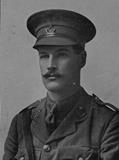
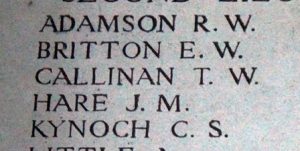
David Brynmor Chiles-Evans, DSO, Lieutenant-Colonel, Royal Army Medical Corps. David was born in Cirencester, Gloucestershire in 1877, the son of Reverend David Evans and Elizabeth Ann Evans (nee Chiles). His father was a Congregational Minister and by 1881 had moved his young family back to his native Wales, settling at Pembrey. David was initially educated at Aberystwyth University but left there to volunteer to serve with the Welsh Hospital in South Africa during the Anglo-Boer War of 1899-1902. He embarked with the staff of the Welsh Ambulance aboard the SS Canada on 14 April 1900 and disembarked in Cape Town, serving as a Dresser with the hospital throughout the campaign, gaining the Queen’s South Africa Medal with clasps: Cape Colony, Orange Free State and Transvaal. When he eventually returned to Wales, he completed his studies and qualified as a doctor. He gained his first position in the Swansea Workhouse, and alongside his work continued to serve with the army volunteers over the coming years, initially as a Lieutenant with the Gloucester and Somerset Bearer Company, Royal Army Medical Corps, then in November 1908, following the formation of the Territorial Army, David was appointed to the 3rd Welsh Field Ambulance, Royal Army Medical Corps, which was based at Swansea. In 1910 he set up in practice in partnership with Doctor E. Brice in the Landore area of Swansea, both men purchasing the practice of the retiring Doctor E.B. Evans. In 1914 David was mobilised with the 3rd Welsh Field Ambulance, but swiftly volunteered to serve overseas, being promoted to Captain and appointed as a Medical Officer with the 1st Battalion, West Yorkshire Regiment. The battalion embarked for France on 10 September 1914 attached to 18 Brigade, 6th Division, then entrained for the Aisne to join the rest of the BEF which was under intense pressure. On 1 October, after weeks of heavy fighting, the division was relieved and began to move north with the BEF to Flanders, taking over positions near Bois Grenier by 17 October. David was wounded here on 20 October during a German assault on the division’s positions. He soon returned to duty, and was wounded again later that year, at Hooge on 9 August 1915. When he returned to duty David was posted to the 18th Field Ambulance, which was in the same 6th Division, and saw further action during the Battle of Loos in September. David was the medical Officer that examined the detainee Private Harry Farr of the 1st West York’s early in 1916, after he had twice been treated for being ‘nervy’. Harry was subsequently executed for Cowardice, a sentence which has only in recent years been rescinded, and a full pardon given him. David was awarded the Distinguished Service Order for his work at Loos in the King’s Birthday Honours List of 31 May 1916 and returned home to receive the award during an Investiture at Buckingham Palace. In the summer of 1916, the 6th Division moved south to the Somme. David was wounded here, at Ginchy, on 17 September 1916, and enjoyed a brief spell of leave at home to recuperate before returning to duty again and on 9 March 1917 he was promoted from Captain to Lieutenant-Colonel and given command of the 18th Field Ambulance. The division moved to the Arras sector soon afterwards and saw heavy fighting around Hill 70. David was badly wounded by shell fragments whilst at work with his Field Ambulance on 23 April 1917, but bravely remained on duty until being hit again half an hour later and died soon afterwards that same day. The body of the 40-year-old was buried in Bethune Town Cemetery, France. David is also commemorated on war memorials at Burry Port, Swansea and Cardiff University. He had also been mentioned in despatches three times during the war.
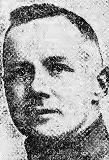
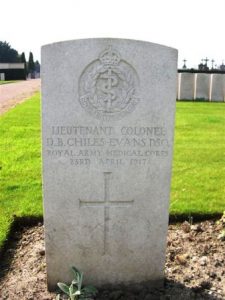
John Robert Collard Dunn, Second Lieutenant, Welsh Regiment. John was born in 1885, the son of Frederick William Dunn and Jennett Dunn (nee Morgan), of The Cross, Llanblethian, near Cowbridge. John studied law as a young man and was admitted to the bar in 1911, before setting up practise at Bridgend. He was a highly regarded rugby player, playing for Old Monktonians (Glamorgan Wanderers), Cardiff RFC and then for London Welsh RFC prior to the war. John and one of his brothers, Frank, enlisted into the 5th Battalion, Welsh Regiment as soon as war erupted. The battalion was the local Territorial unit and mobilised for war at Pontypridd in August 1914, as part of South Wales Brigade, Welsh Division and moved to Tunbridge Wells until the end of the month, before moving to Scotland to man the Forth and Tay Defences. Both John and his brother Frank were commissioned as Second Lieutenants in the battalion during early April 1915, then on 17 April the battalion moved to Bedford, as part of the recently renumbered 158 Brigade, 53rd (Welsh) Division. On 19 July 1915 the entire Division sailed from Devonport for Imbros and on 9 August 1915 landed at Suvla Bay. The infantry moved off the beaches across the Salt Lake, under shellfire, into the scrub covered Chocolate Hill, but due to a lack of maps and no knowledge of the terrain, many of the units became disorientated, and the situation became chaotic. John’s brother Frank was killed in action here on 10 August, during heavy fighting near Anafarta Ova. John survived the initial fighting, but was killed in action ten days later, on 20 August 1915. The 30-year-old has no known grave and is commemorated on the Helles Memorial, Gallipoli. A third brother, Hugh, drowned whilst on leave in May 1916. All three brothers are commemorated on the Llanblethian war memorial.
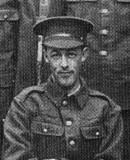
William Henry Edmunds, Surgeon, Royal Navy. William was born at Pontardawe on 18 June 1889, the son of John Zachariah Edmunds and Harriet Annie Edmunds (nee Thomas). The family later moved to Brockweir, in Monmouthshire. William was educated at the West Monmouth School at Pontypool before studying medicine at the South Wales University at Cardiff, where he became a well-known rugby player, playing for Pontypool and Glamorgan County. William then continued to study medicine at the University of London and gained a position at St. Mary’s Hospital in London after qualifying as a surgeon. After moving to the capital, he began playing rugby for London Welsh RFC. Following the outbreak of war, William volunteered into the Royal Navy and was given the rank of Surgeon, before being posted to HMS Pembroke, at Portsmouth. He was then transferred to Chatham, before becoming Medical Transport Officer of the No. 2 Royal Naval Ambulance Train. In this capacity, William treated many of the survivors of the great sea battle, of Jutland, which had raged on 31 May 1916, and must have treated some terribly mutilated men. He was still based in Scotland when he took ill at the end of September 1916 and was invalided to the Western Hospital in Glasgow, where he died of septicaemia on 4 October 1916. The body of the 27-year-old was conveyed to Worcestershire, and he was buried in Kingswood Chapelyard. William is also commemorated on war memorials in Abergavenny and at Cardiff University.
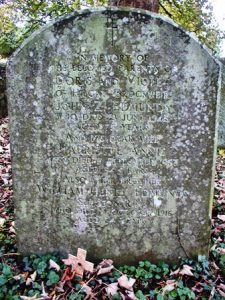
Harry Percy Bright Gough, MC & Bar, Major, Welsh Regiment. Harry was born at Llanelli on 18 January 1880, the son of Frederick George Gough and Sarah Ann Gough (nee Bright). Henry was educated at Llandovery College and trained as a schoolteacher. He played rugby at half-back both for Llanelli and for the Vale of Lune RFC at Lancaster whilst working in the city as a schoolteacher as a young man. Harry married Martha Reid Fullerton in Dublin in 1912, and the couple had two children over the coming years. He must have taught in London at some time after this, when he played rugby for London Welsh RFC, but at the outbreak of war, Henry was Science Master at Oakham Grammar School, in Rutland. He left his post to enlist in the 14th (Swansea) Battalion, Welsh Regiment soon after the outbreak of war. In 1915 Henry was commissioned as Second Lieutenant and was posted to the 17th Battalion, Welsh Regiment. He was then promoted to Captain, at the time of the Battalion’s departure for France in July 1916. The Battalion was attached to 119 Brigade, 40th (Bantam) Division, and moved to the front near Loos. Late in 1916 the division moved south to the Somme, taking part in the Battle of the Ancre, and remained in the area over the winter. In March 1917 the Germans withdrew to their shortened line, called the Hindenburg Line, and the 40th Division was one of the Divisions that followed the withdrawal. Henry distinguished himself in a successful action south of La Vacquerie on 18 May 1917, when a trench raid resulted in the capture of an enemy machine-gun and two unwounded prisoners, at no loss of life to his own men. For his part in the operation, Henry was awarded the Military Cross. During the autumn of 1917, his Battalion was in support of the 12th SWB and 19th RWF in the attempt to capture the stronghold of Bourlon Wood, during the Battle of Cambrai and suffered heavy casualties, losing 17 officers and 301 other ranks. Henry then found himself in command of the severely depleted Battalion. He was awarded a Bar to his Military Cross for his actions here, however, by this time the 17th Welsh had virtually ceased to exist. The Division was caught up in heavy fighting during the spring of 1918, during the German Offensive on the Lys. Henry was sent to command a section of the East Surrey Regiment, which was defending a support trench system running north to south through Strazeele, but on 22 April 1918 was severely wounded, and died at the 62nd London Casualty Clearing Station that same day. The 38-year-old is buried in Arneke British Cemetery, France. His son, Henry Hugh Gough, was killed in Malta in 1942. Henry is also commemorated on the Llandovery College war memorial.
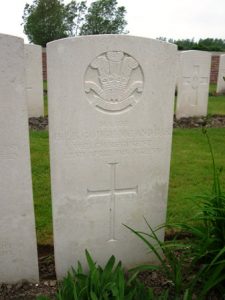
David Jones Capenhurst Jenkins, Sergeant, 12863, Canadian Infantry. David was born on 19 June 1893, the fourth son of the Reverend John Jenkins, and Florence Jenkins (nee Capenhurst), of Wellfield, Llantwit Vardre, near Pontypridd. David was educated at Llandovery College from 1904 to 1911, where he played rugby at outside-half. After leaving Llandovery, David entered Downing College, Cambridge, where he played rugby for Downing College, and also played for London Welsh RFC. Upon leaving Cambridge, David emigrated and became a farmer in Canada. In 1914 David enlisted in the Army at Regina, Saskatchewan, Canada. He became a Trooper in the 16th Light Horse before transferring to ‘B’ Company 5th Infantry Battalion, Saskatchewan Regiment on 3 September 1914. In early 1915, David embarked for France with the 1st Canadian Contingent, and the 5th Battalion became part of 2nd Canadian Brigade, 1st Canadian Division. The Canadians took over the area from St. Eloi to the north of Hooge in early April 1916, and they were in action there until 19 April. Here there were constant attacks by both sides in an area cratered by mines and deep in mud. It was during this period, on 9 April 1916, that David was killed in action near Zillebeke. The 22-year-old was buried in Railway Dugouts Burial Ground, Zillebeke, Belgium. Prior to his death, David had served for 15 months as a despatch runner and was described by one of his officers: “he was the most fearless, painstaking and cool man I have ever had under my command”. Two of David’s brothers, L/Cpl Morgan Jones Jenkins, Princess Patricia’s Canadian Light Infantry, and 2nd. Lt. Richard Jenkins, Manchester Regiment, were also killed in the Great War. David is also commemorated on the war memorials at Llantwit Fardre, Church Village and at Llandovery College.
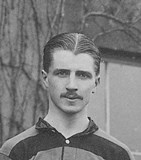
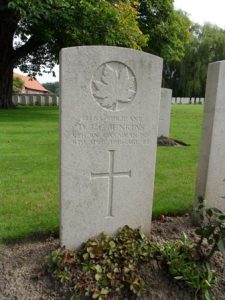
Gwilym Jones, Second Lieutenant, Lincolnshire Regiment. Gwilym was born in 1888, the son of William Jones and Eleanor Jones, of 54, Llewellyn Street, Pontygwaith. Upon leaving school he trained as a schoolteacher, before gaining a position at Tylorstown. Gwilym was a renowned rugby player, having played as three-quarter in the Neath championship winning side of 1909-10 and in 1910-11. He had also played for Pontypridd, Cardiff, London Welsh and for Glamorgan County. Gwilym married Margaret Anne Gobert, of Aberystwyth, in 1915 and the couple had a son, Gwilym, born in Tylorstown in 1916. Gwilym originally enlisted as a private into the 3rd Battalion, Welsh Regiment, then on 14 January 1918 was commissioned as Second Lieutenant into the Lincolnshire Regiment. Gwilym was not drafted to France until the summer, when he joined the 8th Battalion, Lincolnshire Regiment in the Arras sector on 13 August 1918. The battalion was attached to 63 Brigade, 37th Division and was in the trenches in front of Bucquoy when Gwilym arrived. Four days later, after a quiet spell in the line, the battalion was relieved and moved into reserve at Souastre. By now the Allies were set for a great offensive along this sector of the line, and at dawn on 21 August 1918 the 8th Lincolns took part in a frontal assault on Bucquoy from the direction of Pigeon Wood. Over the coming days the division captured Achiet-Le-Grand and Bihucourt, as the Allies began driving the Germans back towards the Hindenburg Line, crossing the Bapaume Road as the Germans were driven back. By 5 September the 37th Division had reached Havrincourt Wood, and two days later began driving forward again. Gwilym was killed in action during an assault on Knife Trench on 10 September 1918. The 31-year-old was buried in Hermies Hill British Cemetery, France. His son, Gwilym Louis Gobert Jones, was killed at sea in 1940.
Brinley Richard Lewis, Major, Royal Field Artillery. Brinley was born on 4 January 1891, the son of David Lewis and Margaret Lewis (nee Davies), of Tanyrallt, Pontardawe. He was educated at Swansea Grammar School and at Cambridge University, where he gained three Blues. He played club rugby for London Welsh and Newport and gained the first of his two caps against Ireland in 1912. He had joined the Glamorgan Yeomanry in October 1914 and was commissioned into the Royal Field Artillery early in 1915, joining B Battery, 122nd Brigade, Royal Field Artillery, which was attached to the 38th (Welsh) Division, and landed in France with the battery on 25 December 1915. He served with the division during its period of trench initiation in Flanders, and then during its assault on Mametz Wood in July 1916, and moved with the division to positions along the canal bank north of Ypres, where he was promoted to Major. Brinley became the tenth former Welsh international rugby player to be killed during the war, when he was killed on 2 April 1917, aged 26. He is buried in plot 3, row C, grave 1 in Ferme Olivier Cemetery, Ieper, Belgium. He is also commemorated on the war memorial at Pontardawe.
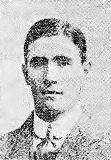
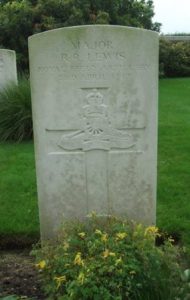
Charles Edward Lewis, Second Lieutenant, London Regiment (Royal Fusiliers). Charles was born in Tenby in 1879, the son of John Phelps Lewis and Fanny Lewis (nee Baggs). His father, a Draper, moved the family to Newport, Monmouthshire by 1884. Charles was educated at Long Ashton School, Bedminster before going to live in Cheltenham as a young man, to work as a house furnishing assistant. Charles began playing Association Football for the town, and was a promising talent, but his first love was rugby, and he made his first appearance for Cheltenham RFC against Stroud on 27 November 1897. Charles returned to Newport by 1901 and that year made his debut for Newport RFC, firstly as a full back, then as a wing, where he showed a knack for scoring tries. In 1904 Charles left Newport to take up a position in London as a Relieving Officer and began playing rugby for London Welsh. On 15 July 1911 he married Margaret Helen Bushell, at St. James Church, Bethnal Green. Charles enlisted into the London Regiment soon after the outbreak of war and was commissioned as Second Lieutenant into the 1st/4th Battalion, London Regiment (Royal Fusiliers). He embarked for France on 11 July 1916, joining the 4th Battalion, London Regiment at Bayencourt four days later, where it was attached to 168 Brigade, 56th (London) Division. The battalion was rebuilding following heavy losses during the opening phase of the Somme offensive during the preceding days, when the division took part in a diversionary attack on Gommecourt. On 17 July the battalion moved back into the trenches at Hébuterne, to begin a short tour in the trenches, enduring a trying few days, often under heavy artillery fire. The division remained in the same sector over the coming weeks, as the main fighting raged to the south, then in the middle of August was relieved and moved into the rear areas to rest and rebuild. By 5 September the division had began moving back into the battle zone, before moving forwards into positions near Leuze Wood in readiness to take part in the Battle of Ginchy. The 56th Division moved into a section of line between the Combles ravine and the boundary with the 16th (Irish) Division on the Combles–Guillemont road, before launching its assault at dawn on 9 September 1916 behind a creeping artillery barrage. Charles was killed in action during the assault that morning. The 36-year-old has no known grave and is commemorated on the Thiepval Memorial, France. Charles is also commemorated on the Newport Athletic Club war memorial.
David Gray Lloyd-Williams, Second Lieutenant, King’s Own (Royal Lancaster Regiment). David was born on 2 August 1895, the son of Hugh Lloyd-Williams and Dorothy Ann Lloyd-Williams (nee Gray), of 19, Blenheim Gardens, Cricklewood, London. His parents were both from North Wales but had moved to London where Hugh ran his own dental practise in Harley Street. David was still only 18 years of age when he began playing rugby for London Welsh, but a promising rugby career was cut short following the outbreak of the Great War. He was commissioned as Second Lieutenant into the King’s Own (Royal Lancaster Regiment) in October 1914 and was posted to the 6th Battalion, King’s Own, which had recently formed in Lancaster. The newly formed battalion then moved to Tidworth to join 38 Brigade, 13th (Western) Division and in February 1915 moved with the division to Aldershot to complete its training. On 13 June 1915 the division embarked for Egypt, then on 6 July landed on the shores of Gallipoli, to take part in the forthcoming Battle of Sari Bair. Initially 38 Brigade was held in reserve whilst 40 Brigade took part in an assault alongside the Anzacs against Chunuk Bair. The Turks counter-attacked on the morning of 10 August 1915 and 38 Brigade was ordered forward to help hold the line. David was killed in action during the heavy fighting which followed that day. The 20-year-old has no known grave and is commemorated on the Helles Memorial, Gallipoli.
Hopkin Thomas Maddock, MC, Lieutenant, Machine Gun Corps. Hopkin was born at Margam in December 1881, the son of Jonathan Maddock and Elizabeth Maddock (nee Thomas). He was educated at Christ College, Brecon where his talent as a fine rugby winger came to the fore. Upon leaving school, his parents had moved to Pontycymmer, so Hopkin played club rugby for Pontycymmer and Glamorgan, where his great talent for try-scoring became noticed by London Welsh. He was then given a position as a clerk with London County Council and played for London Welsh and Middlesex. Hopkin’s talents became noticed on the wider stage, and he was selected for his first Welsh cap against England at Richmond on 13 January 1906 and during four seasons playing for Wales scored six tries, as well as 170 tries for London Welsh. Soon after the outbreak of war Hopkin enlisted into the 21st (4th Public Schools) Battalion, Royal Fusiliers on 15 September 1914. The battalion was raised at Epsom before moving to Ashstead from October 1914 to March 1915 as part of 98 Brigade, 33rd Division. Hopkin embarked for France with the battalion on 14 November 1915 and the Division moved to the Beuvry Sector for trench initiation. In February 1916 the 21st Battalion was disbanded. Hopkin would have been transferred to another battalion before being commissioned as Second Lieutenant into the Machine Gun Corps on 25 September 1916. Hopkin gained the award of the Military Cross for his gallantry at Les Mesnil during the German Spring offensive of 21 March 1918. His award was published in the London Gazette of 16 September 1918 and read: ‘For conspicuous gallantry and devotion to duty. This officer, during a withdrawal, held on unsupported by infantry until almost surrounded, when he withdrew in good order, doing great execution as he retired. He was the last to cross a bridge before its destruction.’ He survived the war, but his time on the Western Front had taken a heavy toll on his health. He died at Cardiff on 15 December 1921, too late to be commemorated as an official war casualty. The 40-year-old was buried in Saint Cynwyd Church Cemetery, Llangynwyd. He is also commemorated on the war memorial at Christ College, Brecon.
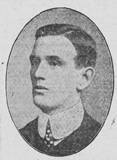
Norman Chester Newland, Second Lieutenant, Monmouthshire Regiment. Norman was born in 1888, the son of Alfred Newland and Elizabeth Chester Newland (nee Mace), of Lawnside, Circle Park, Newport, Monmouthshire. Norman was educated at Denstone, then studied law before being accepted for the bar in 1911. Norman began his rugby career playing for his local club, Newport RFC, before his work took him to London and he began playing for London Welsh. Norman enlisted into the army at the outbreak of war and was commissioned as Second Lieutenant into the 1st Battalion, Monmouthshire on 13 September 1914. The battalion had mobilised at Stow Hill, Newport as part of the Welsh Border Brigade, Welsh Division before moving to Pembroke Dock, then on 10 August 1914 the Division moved to Oswestry before moving to Northampton, spending Christmas at Bury St. Edmunds before moving to Cambridge. In February 1915 the 1st Monmouth’s left the Welsh Division and embarked for France at Southampton on 14 February, disembarking at Le Havre the following day before entraining for Cassel and marched to billets at Dranoutre. The battalion then moved to Wulverghem and joined 84 Brigade, 5th Division before moving into the trenches for the first time. On 6 April, 84 Brigade moved to Locre to re-join the 28th Division before taking over positions at Frezenberg Ridge. On 22 April, just to the north, the Germans launched the first gas attack of the war upon French Colonial troops at Gravenstafel, heralding the opening of the Second Battle of Ypres. The fighting remained to the north of Polygon Wood until 3 May, when the Germans widened their attacks and the Polygon Wood sector was evacuated by the 28th Division, which fell back on the G.H.Q. line at Potijze. Over the coming days their new positions were shelled mercilessly, then on 8 May the Germans attacked. Despite heavy losses the Division held firm, but all of its infantry battalions had been almost decimated. Norman was wounded and taken prisoner by the Germans on 11 May and was evacuated to the German Military Hospital at Roulers. He died there of his wounds on 31 May 1915. The 27-year-old was buried in Roeselare Communal Cemetery, Belgium.
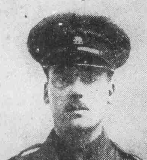
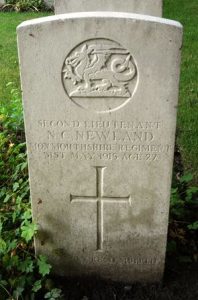
John Forbes O’Connell, Lieutenant, Royal Army Medical Corps. John was born at Neemuch, India on 18 February 1889, the son of Captain David Valentine O’Connell and Alice Susannah O’Connell (nee Bevan). His father was a surgeon with the Royal Army Medical Corps and three years later the family had returned to England, and David was based at Aldershot. John was educated at Epsom College, and then at St. Marys Hospital, following his father into the medical profession and graduating M.B., B.S. of the University of London in 1912. He played rugby for London Irish and for London Welsh whilst studying and continued to play rugby after gaining a position as house physician at St Mary’s Hospital and later as assistant resident medical officer at Hanwell Asylum. John then enlisted into the Royal Army Medical Corps, gaining a commission as Second Lieutenant on 24 January 1913, and was stationed at the Connaught Hospital, Aldershot. He married Gladys Muriel Arlow in the spring of 1914 and the couple had a home at Mumbles, Swansea. Following the outbreak of war John joined the medical staff of the 2nd Battalion, Highland Light Infantry, and disembarked in France with the battalion on 13 August 1914. The battalion was attached to 5 Brigade, 2nd Division and entrained for the Belgian frontier, taking part in the Battle of Mons on 23 August 1914, then in the epic retreat south, which saw the division take part in the Affair of Landrecies, the Rearguard Actions of Villers-Cotterets, and at the Battle of the Marne where the German offensive was stopped. The British and French then advanced, driving the Germans back towards the Chemins Des Dames Ridge, where they dug in, and met them in battle again, during the Battle of the Aisne. John had already gained a reputation as a gallant man, who was not afraid to go forward into No Man’s Land to help collect wounded men. On 20 September 1914, during a counterattack by the Germans, John rushed forward to help a wounded officer from his battalion but was shot dead. The 25-year-old was buried in Vendresse British Cemetery, France.
Richard James Pawley, Second Lieutenant, Royal Garrison Artillery. Richard was born in 1887, the son of George Pawley and Mary Pawley (nee Hosking), of 115, Maughan Street, Penarth. Upon leaving school he gained work as a draper’s assistant at Penarth, before moving to London and lodged at 30, Sinclair Mansions, Fulham. Richard had played rugby for Penarth before moving to London and was then signed by London Welsh RFC. He married Mary Louisa Drewett in Fulham in the spring of 1915. Richard enlisted into the Royal Flying Corps on 4 May 1916 but was later commissioned as Second Lieutenant into the Royal Garrison Artillery, before disembarking in France on 16 June 1918 and being posted to the 92nd Siege Battery, Royal Garrison Artillery. Richard survived the war but was invalided home just after the Armistice. He died in hospital in London on 28 November 1918, probably of influenza. The 31-year-old was buried in Seaford Cemetery, England.
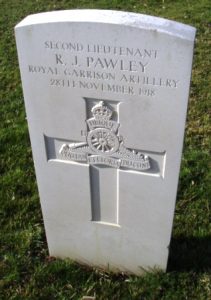
Lawrence Sinclair Rees, Second Lieutenant, Welsh Regiment. Lawrence was born in July 1889, the son of Thomas Rees and Mary Hannah Rees, of Cloth Hall, Market Street, Llandovery. An elder brother, Conway Rees, had played rugby for Wales. Lawrence was educated at the Royal Masonic School in Rickmansworth from 1899-1905 and played rugby for London Welsh. He went to Germany to train as a furrier prior to the war but swiftly returned home to enlist into the Public Schools Battalion, Royal Fusiliers. On 19 August 1915 Lawrence was commissioned as Second Lieutenant into the Welsh Regiment and was posted to Winchester to join the 13th Battalion, Welsh Regiment, which was attached to attached to 114 Brigade, 38th (Welsh) Division. On 2 December 1915 the battalion moved to France, and the entire Division moved to the Fleurbaix sector, where it was initiated into trench warfare. During June 1916 the Division marched south to the Somme, and on 7 July 1916 attacked Mametz Wood. The initial attack failed, and it was three days later, on 10 July, that a fresh attack was mounted. Lawrence was killed in action during the heavy fighting of 10 July 1916. The 26-year-old has no known grave and is commemorated on the Thiepval Memorial, France. Lawrence is also commemorated on the war memorial at Llandovery.
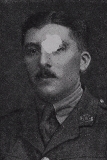
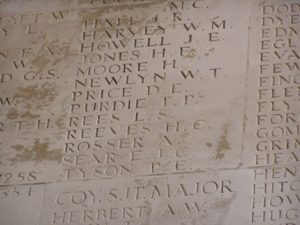
George Lewis Rogers, Private, 20463, Border Regiment. George was born in 1883, the son of John Rogers and Ann Rogers (nee Lewis), of Caerelms, Llanelli. He was educated at Pentip School at Llanelli, before gaining work as a Drapers Assistant at Bradford House, Llanelli. George then gained a position as private secretary to Mr. Harold Williams, of Hitchcock, Williams and Co. Drapers in London. Whilst living in the city he played rugby for London Welsh, before later becoming secretary of the London Irish Rugby Club and the London Olympic Association. George enlisted at Carlisle into the Royal Army Medical Corps soon after the outbreak of war, but later transferred to the 6th Battalion, Border Regiment in order to go to France to fight. He was drafted to France in the summer of 1916 and was posted to the 1st Battalion, Border Regiment, which was attached to 87 Brigade, 29th Division. The Division had seen extensive action during the Gallipoli campaign the previous year, remaining there until evacuation to Egypt on 11 January 1916 and then had moved to the Western Front on 15 March 1916. The Division took part in its first major action in France during the opening day of the Somme Offensive on 1 July 1916, suffering terrible casualties during its assault on Y-Ravine. The Division was then pulled out of the line to rest and rebuild in the Ypres Salient before moving back into the line and taking part in the latter stages of the Somme offensive. George was wounded during a spell in the line near Gueudecourt and was evacuated to the Casualty Clearing Station at Heilly, in the Somme Valley, where he died of his wounds on 28 October 1916. The 34-year-old is buried in Heilly Station Cemetery, France. He is also commemorated on the Pentip School war memorial at Llanelli.
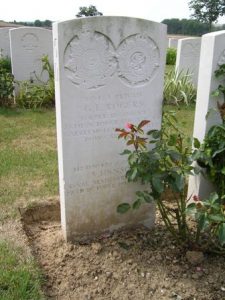
Charles Gerald Taylor, MVO, Engineer Captain, Royal Navy. Charles was born at Ruabon on 8 May 1863, the son of Reverend Alfred Lee Taylor and Annie Taylor. His father was headmaster of Ruabon Grammar School, where Charles was educated. He had played football for his home club of Ruabon before joining the Royal Navy in 1879 and became an acting assistant engineer. Charles then began playing rugby for the Royal Navy, which led to him gaining nine Welsh caps during an international career which lasted from 1884 until 1887 and had also been Welsh pole-vaulting champion. He was stationed in London for a prolonged period of time, playing rugby for Blackheath, and became one of the founder members of the London Welsh RFC, playing in the clubs very first game in 1885. Charles played his rugby alongside continuing to serve in the Royal Navy and had risen to the rank of Engineer Captain by the time war erupted and had been appointed a Member of the Royal Victorian Order in 1911. He had married Mary Cardwell at Chorley in 1896 and the couple had two children. Charles was posted to the battlecruiser HMS Queen Mary in August 1914, then on 20 November 1914 was transferred to HMS Tiger. On 24 January 1915, Tiger was one of the vessels engaged in the Battle of Dogger Bank and was struck by shellfire from the German cruiser SMS Blücher. Taylor was killed when a German shell burst below the conning tower during the engagement. The body of the 51-year-old was returned to Britain to be buried at Tavistock New Cemetery in Devon. He is also commemorated on the Ruabon war memorial. Interestingly, his daughter, Nancy, gained her pilots certificate in 1937.
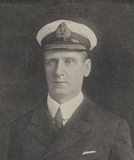
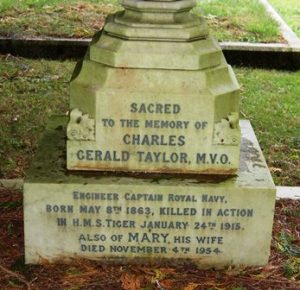
Horace Wyndham Thomas, Second Lieutenant, Rifle Brigade. Horace was born in Pentyrch on 28 July 1890, the son of Reverend Morgan Thomas and Mary Priscilla Thomas (nee Jones). He was educated at Monmouth Grammar School and at King’s College, Cambridge, where he gained his Cambridge Blue in 1912, during the Varsity match which saw Cambridge beat Oxford for the first time in seven years. Whilst at Cambridge he also sang in the college choir, was a member of the musical and dramatic societies, and played almost every sport the college had to offer. He was picked for his first Welsh cap that year, against South Africa. He also played for Blackheath, London Welsh, Swansea and the Barbarians, and gained another Welsh cap in 1913, before joining the Mercantile Marine and was based in Calcutta, where he continued to play rugby and cricket and became captain of the Calcutta Football Club. Following the outbreak of war, Horace returned home to take up a commission as Second Lieutenant into the 14th Battalion, Rifle Brigade in January 1916, before being attached to the 16th Battalion, Rifle Brigade, which was attached to 117 Brigade, 39th Division. Horace landed at Le Havre, France with the battalion on 8 March 1916 and the battalion moved to the Sailly Sur La Lys sector with the division for trench initiation and training alongside the 8th Division in the Nursery Sector. The 39th Division then took over the Annequin North sector near Bethune, where it remained until moving to the Givenchy-Festubert sector the following month. The division was eventually relieved on 6 August and began to move south to join the great offensive on the Somme, and the 16th Rifle Brigade took over billets at Bertrancourt by 28 August, prior to the division moving into the line north of the river Ancre on the night of 2 September. On the following morning, 3 September 1916, the 39th Division launched an assault along the north bank of the Ancre, but suffered terrible casualties, with the 16th Rifle Brigade alone losing over 400 officers and men killed, wounded or missing. Horace had been killed in action by shellfire during the attack that day, just after reaching the German front line. The 26-year-old has no known grave and is commemorated on the Thiepval Memorial, France. Horace is also commemorated on the Bridgend war memorial.
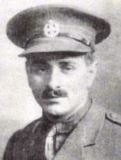
Thomas Johns Tucker, MM, Sergeant, 2173, London Regiment. Thomas was born on 13 June 1886, the son of Henry Tucker and Ellen Tucker (nee Johns), of 82, Oxford Street, Swansea. Thomas and his brother Aubrey followed their father into the Drapery trade as young men. Thomas then left Swansea to work in a large drapery business, Messrs. Owen, at Hatton Gardens, London prior to the war and whilst living there played rugby for London Welsh. Thomas enlisted into the 1/16th Battalion, London Regiment (Queen’s Westminster Rifles) at Westminster on 5 August 1914 and was posted to the barracks at Queen’s Hall, Buckingham Gate, Westminster. The battalion was a Territorial Army unit and was attached to the 4th London Brigade, 2nd London Division. At the end of August, the battalion moved to the Hemel Hempstead area, then in November 1914 left the 2nd London Division and went to France, landing at Le Havre on 3 November 1914, joining 18 Brigade, 6th Division near Frelinghien, in Flanders. The battalion then took part in the Christmas Truce, the men mingling with troops of the German 107th Regiment. The 6th Division moved into the Ypres Salient at the beginning of June 1915 and in August took part in an attack which regained Hooge from the Germans. After wintering in the Salient, on 10 February 1916 the Queen’s Westminster’s transferred to 169 Brigade, 56th (London) Division, which was forming in the Hallencourt area. The division then spent several weeks training in the Somme back areas, before moving into the line east of Hébuterne. The Somme offensive had by now been planned to open, and the British were to attack north of the river Somme, in conjunction with a French attack to the South. As part of this plan, the 56th Division was ordered to make a diversionary attack on Gommecourt, to attempt to draw German attention away from the main offensive just to their south. At dawn on 1 July 1916 the division attacked, with the Queen’s Westminster’s assaulting Gommecourt. Thomas was killed in action during the assault that morning, shot through the heart. He was among over 500 casualties suffered by his battalion that day, a terrible tragedy. Sadly, Thomas had only just received news that he was to be awarded the Military Medal, for his work leading up to the tragic assault. The 30-year-old has no known grave and is commemorated on the Thiepval Memorial, France. He is also commemorated on the Swansea Cenotaph.
Hugh Ince Webb-Bowen, Captain, Royal Welsh Fusiliers. Hugh was born on 12 February 1878, the eldest son of Thomas Ince Webb-Bowen, late Chief Constable of Pembrokeshire, and Ellen Webb-Bowen (nee Brenchley), of Tenby. He was educated at Haverfordwest Grammar School, before studying law and was admitted to the Bar in 1889. Hugh played rugby for London Welsh as a young man, before enlisting into the army, gaining a commission as Second Lieutenant into the Royal Welch Fusiliers and was drafted to South Africa in 1900 to join the 1st Battalion, Royal Welch Fusiliers, taking part in the Anglo-Boer War, where he gained a reputation for his gallantry. Hugh remained in the army after the war but was seconded to the South African Constabulary for three years before re-joining his regiment in India. Soon after his arrival he was made Adjutant. He was then transferred to the Head Quarter’s Staff of the Egyptian Army and was stationed at Khartoum, but in July 1914 returned to England and married Evelyn Flora Abercromby McDougal in Kensington on 18 July 1914. The couple were still on honeymoon when war broke out and Hugh was recalled to Khartoum. Evelyn joined him there soon afterwards, but by then the war on the Western Front had stagnated into static trench warfare, so the Allies, at the behest of Winston Churchill, came up with the idea of opening another front in an attempt to take Turkey out of the war. The initial plan was to force the Dardanelles Straits by use of a combined Anglo-French fleet, but severe losses were suffered from mines, so on 25 April 1915 the Allied landed on the Gallipoli Peninsula, intending on crossing over the land and capturing Constantinople. As part of the build up to this invasion, Hugh was despatched to the Mediterranean to join the Head Quarters Staff, landing after the initial infantry assault. He was sadly wounded on Gallipoli during the early stages of the campaign there and died of wounds on 24 May 1915. The 37-year-old is buried in Lancashire Landing Cemetery, Gallipoli. He is also commemorated on the St. Martin of Tours war memorial at Haverfordwest.
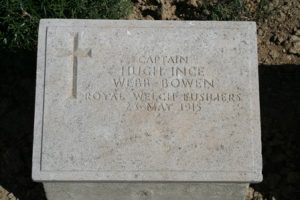
John Lewis Williams, Captain, Welsh Regiment. John was born on 3 January 1882, the son of Edward Williams and Mary Williams (nee Lewis), of Llwyncelyn, Whitchurch. His father was one of the owners of the firm of Messrs. Greenslade and Williams, coal exporters, Cardiff Docks. John was educated at Cowbridge Grammar School, where he excelled at football. John concentrated on rugby after leaving school, playing for Whitchurch before joining Newport RFC, but soon moved to Cardiff RFC, and playing his first match for the club in 1903 and later becoming Club Captain. He made a solitary appearance for London Welsh in 1905. John played for Wales seventeen times on the wing between 1906 and 1911, when he retired and had been a member of the Anglo-Welsh team that toured New Zealand and Australia in 1908. After retiring from rugby John concentrated on the family business. He enlisted into the Welsh Regiment at Cardiff soon after the outbreak of war, gaining a commission as Second Lieutenant into the 16th Battalion, Welsh Regiment. The battalion, known as the Cardiff City battalion, was raised at Cardiff in November 1914 by the Lord Mayor and Corporation, before moving to Colwyn Bay in December 1914, joining 130 Brigade, 43rd (Welsh) Division. On 29 April 1915 the formation became renumbered to 115 Brigade, 38th (Welsh) Division, before moving to Winchester to complete its training. The battalion moved to France on 4 December 1915 and moved to the Nursery Sector near Fleurbaix with the division for trench initiation alongside the Guards Division. The Division then held a sector of the line near Cuinchy before marching south to the Somme sector in June 1916 to take part in the assault on Mametz Wood. By now John had been promoted to Captain and was in command of C Company. The first attack on Mametz Wood was launched on a two-battalion front on 7 July 1916, with the 16th Welsh attacking from the slope facing the wood, with the 11th South Wales Borderers in support and the 10th South Wales Borderers in reserve. The men launched their assault at 08.30 behind a poorly placed artillery barrage and immediately came under heavy machine-gun fire from Mametz Wood and enfilade Fire from Flatiron Copse and Sabot Copse. The 16th Welsh had suffered terrible losses and the survivors were forced to retire with over 280 men killed, wounded or missing. John had been wounded during the assault and was slowly evacuated to the hospital at Corbie for treatment. He died of his wounds there on 12 July 1916. The 34-year-old is buried in Corbie Communal Cemetery Extension, France. John is also commemorated on the Whitchurch Cenotaph.

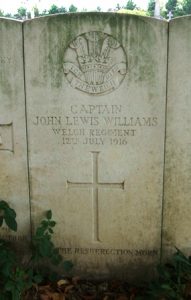
Walter Hall Williams, Sergeant, 41, London Regiment. Walter was born in 1880, the son of Thomas Williams and Elizabeth Williams, of 18, Union Street, Cardiff. His father worked as a Police Officer and later a Chief Inspector for the Board of Trade, and Walter later followed in his father’s footsteps, and began working for the Board of Trade in Cardiff. Over the coming years he began climbing the ladder, becoming a Deputy Superintendent for the Board of Trade in the Mercantile Marine Office in London and started playing rugby for London Welsh. Walter was also a member of the Territorial Army, and had joined the 15th Battalion, London Regiment (Civil Service Rifles) upon its formation in 1908. The battalion mobilised for war at Somerset House on 4 August 1914 attached to the 4th London Brigade, 2nd London Division, before moving to Bedmond, near Hemel Hempstead. By November 1914 the battalion was billeted in Watford, then on 18 March 1915 landed at Le Havre. The division then entrained for Flanders, moving to the Bethune area, before taking over positions at Givenchy. On 11 May the formation became renumbered to 140 Brigade, 47th (2nd London) Division, and took part in the bloody battles of Aubers Ridge, and the ensuing Battle of Festubert that month. The division then moved to the Loos Sector and from 25 September onwards took part in the Battle of Loos, and subsequent Action of Hohenzollern Redoubt. The battered division then moved to the Souchez sector and took part in heavy fighting when the Germans attacked Vimy Ridge the following spring. In July 1916 the division was relieved and began to move south to join the great Somme offensive, reaching Naours by 22 August after completing a training scheme behind the lines, then on 12 September the division took over positions near Becourt Wood, in order to take part in the Battle of Flers-Courcelette. The Civil Service Rifles took over positions in High Wood on 14 September, then at dawn on the following day, 15 September 1916, launched an assault against the German held portion of the wood. The initial assault was successful, but B, C and D Companies of the battalion were mown down by heavy machine-gun fire, suffering terrible casualties. Walter was 35 years old when he was killed in action in High Wood that day. He has no known grave and is commemorated on the Thiepval Memorial, France. Walter is also commemorated on the Board of Trade War Memorial in Whitehall, and by the Civil Service Rifle Memorial, at Somerset House.
Walter Kent Williams, MVO, Engineer Captain, Royal Navy. Walter was born at St. David’s on 24 October 1863, the son of William Philips Williams and Mary Williams (nee Kent). His father was a newspaper reporter, so the family regularly moved around the country. Walter was educated at Cardiff, and at the Royal Naval College at Devonport, and had been in the Royal Navy for 29 years prior to the war. At the outbreak of war, he was posted to HMS Bulwark, a Formidable Class Battleship. Before the war, Formidable had been commanded by Captain Robert Falcon Scott. She joined the 5th Cruiser Squadron, and was stationed near Sheerness in November 1914, where she carried out patrols in the English Channel. On 26 November 1914 she was at anchor off Sheerness when she suddenly exploded and sank with the loss of 736 men. Walter was killed aboard the Bulwark that day. He was 51 years old, and is remembered on the Portsmouth Naval Memorial, Hampshire. A subsequent investigation came to the conclusion that incorrectly stores cordite charges had overheated and created a massive internal explosion that tore the ship apart. Witnesses reported that “a huge pillar of black cloud belched upwards… From the depths of this writhing column flames appeared running down to sea level. The appearance of this dreadful phenomenon was followed by a thunderous roar. Then came a series of lesser detonations, and finally one vast explosion that shook the Implacable from mastheads to keel.”
